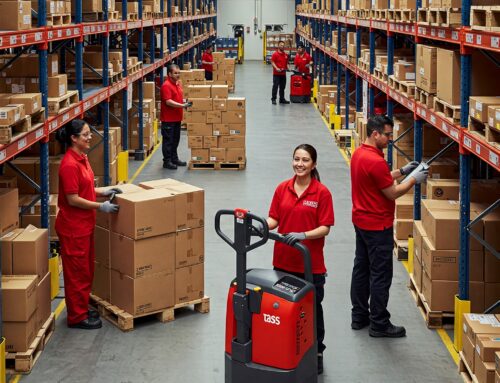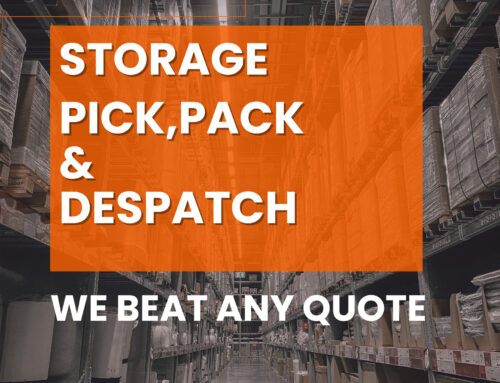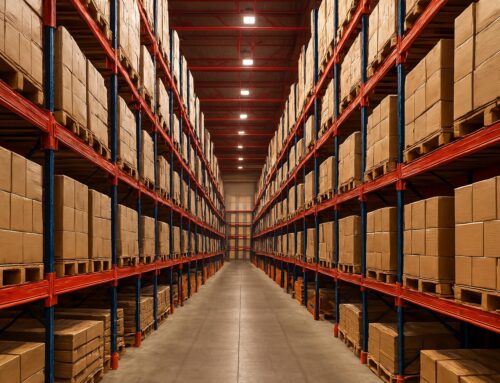Choosing the right storage method for your business is about more than just saving space — it’s about aligning your logistics with your operational goals, product types, and growth plans. For many businesses, the decision comes down to pallet storage vs bulk storage.
Each method has its strengths. The key is understanding which one suits your stock, your supply chain, and your long-term strategy best.
In this guide, we’ll break down the differences between pallet and bulk storage, explore the pros and cons of each, and help you decide which option fits your inventory needs.
Need a storage setup that’s tailored to your business? Call Brenda at TASS Enterprise on 01992 511051 or visit www.tasshertford.co.uk.
What Is Pallet Storage?
Pallet storage is a convenient and efficient way to store goods using standardised wooden or plastic pallets. These pallets are placed within racking systems in warehouses, making it easier to organise, access, and transport items with forklifts or pallet trucks. This method helps streamline operations and maintain a tidy storage area, especially for businesses handling large quantities of inventory.
Ideal for products packaged in boxes or cartons, pallet storage works best for stock that’s already palletised by suppliers. It’s perfect for businesses needing organised and quick-access storage solutions or dealing with goods that have moderate turnover and predictable rotation.
By using pallet storage, companies can optimise space and simplify inventory management while ensuring their items are stored securely and efficiently.
What Is Bulk Storage?
Bulk storage refers to storing goods directly on the warehouse floor without the use of racks or pallets. This method is commonly used for items that are large, heavy, or irregularly shaped, as well as materials stored in containers like drums, bins, or tanks for liquids and powders.
Products received in bulk quantities with minimal packaging are also well-suited for this storage approach. By designating specific zones for bulk storage, businesses can efficiently manage large volumes of stock.
This storage method is ideal for companies that don’t require frequent access to their inventory. It’s especially beneficial for industries handling raw materials, construction supplies, or other bulky items. Bulk storage provides a cost-effective and straightforward solution for managing large, unstructured inventories without the need for additional shelving or complex storage systems.
Pallet Storage: Pros and Cons
Advantages of Pallet Storage
1. Space Efficiency
By using vertical racking systems, pallet storage maximises warehouse height and footprint. Great for high-density storage.
2. Accessibility
Forklifts can retrieve pallets quickly and safely — making it easier to access specific SKUs without moving other stock.
3. Inventory Accuracy
Stock can be clearly labeled, categorised, and counted per pallet — reducing errors and improving visibility.
4. Scalability
It’s easy to add more racking as your needs grow or consolidate pallets as volumes change.
5. Faster Fulfilment
Perfect for fast-moving goods that require regular picking and dispatch.
Disadvantages of Pallet Storage
- Requires palletised goods or repacking at the warehouse
- May need specialised equipment (forklifts, racking)
- Less suited to oversised or irregular-shaped products
TASS offers flexible pallet storage with short- and long-term options — ideal for e-commerce, wholesale, and seasonal stock.
Bulk Storage: Pros and Cons
Advantages of Bulk Storage
1. Suits Non-Standard Goods
Great for items that are too large, heavy, or awkward for pallet racking — such as drums, equipment, or construction materials.
2. Simplified Handling
No need for pallet wrapping or loading — goods are stored as-is, often in large containers or floor zones.
3. Lower Setup Costs
No need to install pallet racking, making it ideal for low-frequency or overflow stock.
4. Good for High-Volume SKUs
If you store large quantities of a few SKUs, bulk storage allows easy stacking in defined zones.
Disadvantages of Bulk Storage
- Can consume more floor space per unit
- Harder to organise, label, and count
- Slower access and picking times
- Greater risk of damage without clear separation
At TASS, we offer both bulk and pallet storage — so you get the right fit no matter your inventory type.
Key Factors When Choosing Between Pallet and Bulk Storage
Choosing the best storage method comes down to how your goods are packaged, how often you move them, and how much space you need. Here’s a closer look at the decision points:
1. Product Type and Packaging
Are your goods packaged in cartons or loose? Are they fragile, perishable, or irregularly shaped?
- Choose pallet storage for boxed items, shrink-wrapped goods, or products already delivered on pallets.
- Choose bulk storage for oversised items, raw materials, or loose stock.
2. Inventory Turnover
How often are items picked and shipped?
- High turnover items (e.g., daily orders) suit pallet storage, where SKUs are easily accessed and moved.
- Low turnover or long-term storage items may be better placed in bulk zones.
3. Storage Volume and Variety
Do you store a wide range of products, or large quantities of a few items?High SKU variety benefits from pallet storage with clear separation.
- High volume, low SKU stock can often be stacked more efficiently in bulk.
4. Space Utilisation
What are your space constraints?
- Limited floor space? Pallet racking uses vertical height for better density.
- Plenty of floor area? Bulk storage can be more cost-effective in open-plan layouts.
5. Handling Equipment
What equipment do you or your storage provider use?
- Pallet racking requires forklifts or reach trucks.
- Bulk storage may need cranes, dollies, or heavy-duty shelving.
At TASS, we’re equipped to handle both — with forklifts, pallet trucks, and designated bulk zones ready to go.
Pallet vs Bulk: Industry Use Cases
E-Commerce Fulfilment
Best option: Pallet storage
Why: Efficient stock rotation, fast picking, SKU visibility
Food and Beverage Storage
Best option: Mix of pallet and bulk
Why: Palletised packaged goods plus bulk storage for ingredients or containers
Construction and Industrial Goods
Best option: Bulk storage
Why: Heavy, oversised, or irregular products that don’t suit racking
Health and Wellness Brands
Best option: Pallet storage
Why: High SKU variety, promotional packing, fast movement
Promotional Campaigns and Kits
Best option: Pallet for pre-assembled stock, bulk for campaign materials
Why: Depends on product type and fulfilment timeline
Need help choosing the right setup? Let’s talk it through – 01992 511051.
Combining Both Methods
Many businesses benefit from using a combination of pallet and bulk storage — especially if they have a mix of product types.
For example
- Bulk storage for raw materials or oversised goods
- Pallet storage for finished products and ready-to-ship items
- Temporary pallet storage for seasonal campaigns or launches
At TASS, we design hybrid storage plans tailored to your business — with flexible space allocation that adapts to your needs.
How We Support Our Valued Clients:
At Tass Hertford, we are proud to work with an exceptional variety of businesses, ranging from local startups to internationally recognised e-commerce brands. We currently provide pallet storage, pick and pack, and despatch services for clients such as GoMate Drinks, UNLTD. Beer, Sakuranna Swimwear, and Nooi Nootropic Drinks.
Our clients rely on us not just for logistics, but also for the confidence that their operations are in capable hands. We take the time to thoroughly understand each brand’s unique requirements, delivering tailored solutions that meet their specific needs.
From creating bespoke influencer gift packs to storing temperature-sensitive products and fulfilling last-minute orders, our dedicated team consistently goes above and beyond to ensure we exceed expectations.
Everything We Do Not Just Storage Solution
We’ve been proudly supporting businesses in Hertfordshire and across the UK for over 20 years, and during that time, we’ve grown far beyond Storage Solution. Our full suite of services means you can rely on one trusted partner to handle your logistics from end to end. We offer:
- Pallet storage – secure, affordable, with short- or long-term options
- Pick, pack and despatch – fast, accurate, and scalable as you grow
- E-commerce fulfilment – including seamless integration with Shopify, Squarespace, Amazon FBA, TikTok Shop, and more
- Contract packing – including bespoke Christmas packing, gift hampers, and subscription boxes
- Influencer gifting – branded boxes, hand-wrapped gifts, handwritten notes, and more
- Container unloading, palletising, and depalletising
- Food and drink logistics – tailored to snack brands, supplement brands, and breweries
- Worldwide shipping – fast and cost-effective, from local to global
- Business storage – for stock, documents, or equipment, with no long contracts
- Office space and hot desking – beautiful workspaces with garden views, kitchen access, and parking
Whatever you need, our small team is always just a phone call away – 01992 511051.
FAQs
How do pallet racking systems compare to shelf storage in warehouse storage?
Pallet racking systems are ideal for high storage density and use of vertical space, making them suitable for bulk goods. In contrast, shelf storage offers easy access for smaller items but typically uses more floor space and has lower storage capacity.
What are the benefits of push back racking in pallet storage?
Push back racking is a type of rack storage that maximises storage space by allowing pallets to be stored several deep. It improves picking efficiency while offering higher storage density within the same warehouse storage area.
How much floor space is needed for bulk vs. pallet storage?
Bulk storage often requires more floor space and is less structured, which may reduce efficiency. Pallet storage with the right racking systems uses vertical space efficiently, offering better warehouse storage solutions for growing operations.
Which option offers more efficient storage solutions for high-volume inventory?
For high-volume inventory, pallet storage with structured pallet racking systems provides more efficient storage solutions. It increases storage capacity and streamlines warehouse flow compared to bulk storage, especially in modern warehouse storage setups.
Conclusion
Choosing between pallet and bulk storage comes down to your product type, order volume, and business goals. The best part? You don’t have to figure it out alone.
A flexible fulfilment and storage partner like TASS Enterprise can help you create a system that works for you now — and grows with your brand.
Whether you need extra space for a short-term overflow, long-term storage for slower-moving items, or a complete fulfilment service, we’ve got your back.
Ready to streamline your storage and take the hassle out of inventory? Give Brenda a call today on 01992 511051 or check us out at www.tasshertford.co.uk. We’re here to help!









